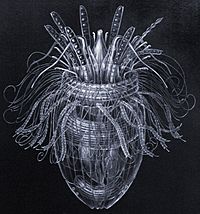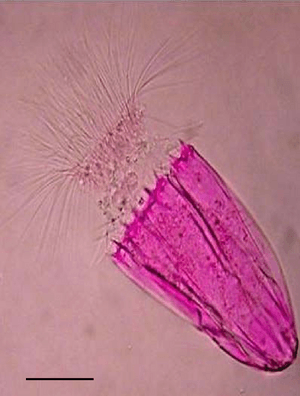Loricifera facts for kids
Quick facts for kids Loricifera |
|
|---|---|
 |
|
| Pliciloricus enigmatus | |
| Scientific classification | |
| Kingdom: | |
| (unranked): | |
| Phylum: |
Loricifera
Kristensen, 1983
|
| Order: |
Nanaloricida
|
Loricifera are tiny marine animals that were discovered not too long ago. They belong to a major group of animals called a phylum. These creatures are very special because some of them can live in places where there is absolutely no oxygen! This phylum was first described in 1983 by a scientist named Reinhardt Kristensen.
These animals are very small, usually living in the sediment at the bottom of the ocean. So far, scientists have officially described twenty-two different species of Loricifera. These species are grouped into eight different genera. However, there are about 100 more species that have been found but not yet fully described. Their size can range from just 100 micrometers (which is super tiny, much smaller than a speck of dust) to about 1 millimeter.
Loricifera live in the tiny spaces between pieces of gravel on the seafloor. They attach themselves very firmly to this gravel. This strong attachment is why they remained hidden from scientists for so long! The first specimen was collected in the 1970s, but it took until 1983 for them to be properly described. You can find Loricifera at all depths of water, in different types of sediment, and all around the world. Scientists have not yet found any Loricifera fossils.
What do Loricifera look like?
These animals have a tough outer shell called a lorica. This lorica protects them. Inside this protective case, Loricifera have a head, a mouth, and a digestive system. Most Loricifera develop directly from an egg, but some species have larvae (young forms) that look different from the adults. Adult Loricifera have two sexes, male and female. Some species have very interesting and flexible life cycles, including ways of reproducing without a partner, called parthenogenesis.
Scientists believe that Loricifera are closely related to two other groups of animals: the Kinorhyncha and the Priapulida. These three groups share some similar features. Together, they form a larger group of animals called Scalidophora.
How Loricifera live without oxygen

Scientists have discovered three species of Loricifera living in the sediment at the bottom of the L'Atalante basin in the Mediterranean Sea. This basin is about 3,500 meters (over 2 miles) deep! These Loricifera are the first known multicellular organisms (animals made of many cells) that can live their entire lives without any oxygen.
How do they do it? Most animals use special parts of their cells called mitochondria to get energy from oxygen. But these Loricifera use different cell parts called hydrogenosomes. Hydrogenosomes do not need oxygen to create energy. This allows these amazing animals to survive in places where no other multicellular animals can.
These newly found animals complete their whole life cycle in total darkness and without any oxygen. They are less than a millimeter in size. They were found in a deep part of the ocean where the water is extremely salty, like a very strong brine. This super salty water is so dense that it doesn't mix with the water above it. Because it doesn't mix, it has no oxygen and contains high levels of ammonia. This environment is very extreme, and only special types of life, called Extremophiles, can survive there. These include certain archaea and bacteria.
See also
 In Spanish: Loricifera para niños
In Spanish: Loricifera para niños

